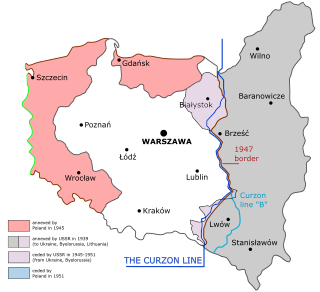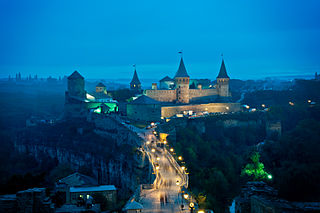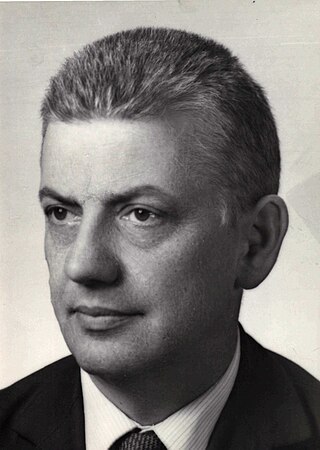
The Curzon Line was a proposed demarcation line between the Second Polish Republic and the Soviet Union, two new states emerging after World War I. Based on a suggestion by Herbert James Paton, it was first proposed in 1919 by Lord Curzon, the British Foreign Secretary, to the Supreme War Council as a diplomatic basis for a future border agreement.

Podolia or Podillia is a historic region in Eastern Europe, located in the west-central and south-western parts of Ukraine and in northeastern Moldova.

The Polish–Soviet War was fought primarily between the Second Polish Republic and the Russian Soviet Federative Socialist Republic, following World War I and the Russian Revolution.

The Republic of Central Lithuania, commonly known as the Central Lithuania, and the Middle Lithuania, was an unrecognized short-lived puppet state of Poland, that existed from 1920 to 1922. It was founded on 12 October 1920, after the successful Żeligowski Mutiny, during which the volunteer 1st Lithuanian–Belarusian Division under the command of general Lucjan Żeligowski seized the Vilnius Region that Lithuania made claims to. It was incorporated into Poland on 18 April 1922.

Polesia, also called Polissia, Polesie, or Polesye, is a natural (geographic) and historical region in Eastern Europe within the East European Plain, including the Belarus–Ukraine border region and part of eastern Poland. This region should not be confused with parts of Russia also traditionally called "Polesie".

Roman Stanisław DmowskiPolish: was a Polish politician, statesman, and co-founder and chief ideologue of the National Democracy political movement. He saw the Germanization of Polish territories controlled by the German Empire as the major threat to Polish culture and therefore advocated a degree of accommodation with another power that had partitioned Poland, the Russian Empire. He favoured the re-establishment of Polish independence by nonviolent means and supported policies favourable to the Polish middle class. While in Paris during World War I, he was a prominent spokesman for Polish aspirations to the Allies through his Polish National Committee. He was an instrumental figure in the postwar restoration of Poland's independent existence. Throughout most of his life, he was the chief ideological opponent of the Polish military and political leader Józef Piłsudski and of the latter's vision of Poland as a multinational federation against German and Russian imperialism.

Red Ruthenia, also called Red Rus' or Red Russia, is a term used since the Middle Ages for the south-western principalities of Kievan Rus', namely the Principality of Peremyshl and the Principality of Belz. It is closely related to the term Cherven Cities.

National Democracy was a Polish political movement active from the second half of the 19th century under the foreign partitions of the country until the end of the Second Polish Republic. It ceased to exist after the German–Soviet invasion of Poland of 1939.

Intermarium was a post-World War I geopolitical plan conceived by Józef Piłsudski to unite former Polish–Lithuanian Commonwealth lands within a single polity. The plan went through several iterations, some of which anticipated the inclusion of neighbouring states. The proposed multinational polity would have incorporated territories lying between the Baltic, Black, and Adriatic Seas, hence the name Intermarium.

Western Krai was an unofficial name for the westernmost parts of the Russian Empire, excluding the territory of Congress Poland. The term encompasses the lands annexed by the Russian Empire in the successive partitions of the Polish–Lithuanian Commonwealth in the late 18th century – in 1772, 1793, 1795 and located east of Congress Poland. This area is known in Poland as Ziemie Zabrane but is most often referred to in Polish historiography and common parlance as part of Zabór Rosyjski. Together with Bessarabia and the former Crimean Khanate, the territory roughly overlapped also with the Jewish Pale of Settlement of the Russian Empire, and included much of what is today Belarus, Ukraine, and Lithuania.

Henryk Zieliński was a Polish historian and professor at the University of Wrocław.

The Treaty of Warsaw of April 1920 was a military-economical alliance between the Second Polish Republic, represented by Józef Piłsudski, and the Ukrainian People's Republic, represented by Symon Petliura, against Bolshevik Russia. The treaty was signed on 21 April 1920, with a military addendum on 24 April.

Volhynia Governorate, also known as Volyn Governorate, was an administrative-territorial unit (guberniya) of the Southwestern Krai of the Russian Empire. It consisted of an area of 71,736 square kilometres (27,697 sq mi) and a population of 2,989,482 inhabitants. The governorate bordered Grodno and Minsk Governorates to the north, Kiev Governorate to the east, Podolia Governorate to the south, Lublin and Siedlce Governorates, and after 1912, Kholm Governorate and Austria to the west. Its capital was in Novograd-Volynsky until 1804, and then Zhitomir. It corresponded to most of modern-day Volyn, Rivne and Zhytomyr Oblasts of Ukraine and some parts of Brest and Gomel Regions of Belarus.

The administrative division of Ukraine in 1918 was inherited from the Russian Empire, and based on the largest unit of the gubernia with smaller subdivisions county or district, and rural district.

Wacław Iwaszkiewicz-Rudoszański was a Polish general.

Duchy of Podolia was a historical state that previously was a part of Kingdom of Galicia–Volhynia. The principality of Southwest Galicia–Volhynia was formed due to the struggle for the legacy of the Kingdom of Galicia–Volhynia. The Duchy was founded by Knyaz George Koriatovich from the Karijotas house.

Civil Administration of the Eastern Lands was a civil authority of the territories controlled by Second Polish Republic but not incorporated into the state itself, that was formed during the Polish–Soviet War in 1919 and existed until 1920. It was formed on 19 February 1919 from the territories taken by Poland during the war, that were previously occupied by the Russian SFSR. In the summer of 1920, forces of Russian SFSR had conquered the area. After part of the area was reconquered by Poland, the administration was formally disestablished on 9 September 1920, and replaced by the Provisional Administration of Front-line and Phase Territories.

Civil Administration of the Lands of Volhynia and Podolian Front, also known as Commissariat of the Lands of Volhynia and Podolian Front was a civil authority of the territories controlled by Second Polish Republic but not incorporated into the state itself, that was formed during the Polish–Soviet War in 1920. It was formed on 17 January 1920 from the Civil Administration of the Eastern Lands and included Volhynian District and the surrounding area. In the summer of 1920, forces of Russian SFSR had conquered the area. After part of the area was reconquered by Poland, the administration was formally disestablished on 9 September 1920, and replaced by the Provisional Administration of Front-line and Phase Territories.

Volhynian District was a district of the Civil Administration of the Eastern Lands from September 1919 to January 1920, Civil Administration of the Lands of Volhynia and Podolian Front from January 1920 to September 1920 and Provisional Administration of Front-line and Phase Territories from September 1920 to December 1920, all of which were under the control of the Second Polish Republic. Its seat was located in Lutsk, and before that, its provisional seat was in Kovel.

The Jełowicki family, sometimes called Jałowiecki, is a Polish princely family of Ruthenian-Lithuanian origin, bearing the Jełowicki arms. They use the prefix Bożeniec. Their estates were originally in Volhynia to the east of the Kingdom of Poland. As Ruthenian nobility, they held the title of kniaz (prince). By the late 16th century, the family converted from Orthodox to Catholicism and became polonized. They eventually left their original settlements at Jałowicze/Jełowicze and Bożeniec. Following their victorious exploits against the invading Tartars King Casimir IV Jagiellon rewarded them in 1444 with the domain of Łanowce in present day Ukraine. They remained on the same land from father to son from 1444 to 1865. Across the centuries, the family produced many civic officials, Prelates and clergy. They are related to other notable houses in the region, including Czartoryski, Rzewuski and Ostrogski. The family is possibly the supposedly "extinct" branch of the Kropotkin family.


















